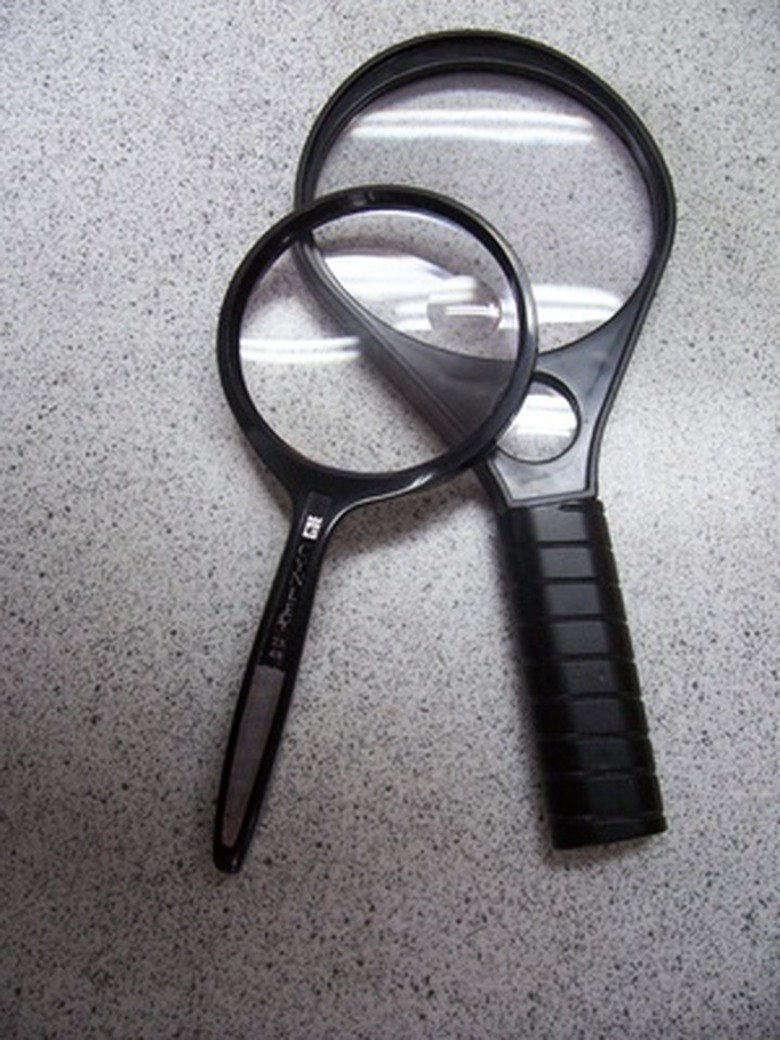How To Calculate Magnification Of A Lens
Lenses, both biological and synthetic, are marvels of optical physics that make use of the ability of certain media to refract, or bend, light rays. They come in two basic shapes: convex, or curved outward, and concave, or curved inward. One of their main purposes is to magnify images, or make them appear larger than they actually are.
Lenses can be found in telescopes, microscopes, binoculars and other optical instruments, along with in your own eye. Scientists and students have a number of simple algebraic equations at their disposal to relate the physical dimensions and shape of a lens to its effects on the light rays that pass through it.
Lenses and Magnification Physics
Lenses and Magnification Physics
Most "artificial" lenses are made out of glass. The reason lenses refract light is that when light rays move from one medium (e.g., air, water or other physical material) into another, their speed changes very slightly and the rays change course as a result.
When light rays enter a double convex lens (that is, one that looks like a flattened oval from the side) in a direction perpendicular to the lens surface, the rays closest to each edge are refracted sharply toward the center, first upon entering the lens and again when leaving. Those closer to the middle are bent less, and the ones passing perpendicularly through the center are not refracted at all. The result is that all of these rays converge at a focal point (F) a distance f from the center of the lens.
The Thin Lens Equation and the Magnification Ratio
The Thin Lens Equation and the Magnification Ratio
Images produced by lenses and mirrors can be either real (i.e., projectable onto a screen) or virtual (i.e., not projectable). By convention, the values of distances of real images (i) from the lens are positive, while those of virtual images are negative. The distance of the object itself from the lens (o) is always positive.
Convex (converging) lenses produce real images and are associated with a positive value of f, whereas concave (diverging) lenses produce virtual images and are associated with a negative value of f.
The focal length f, object distance o and image distance i are related by the thin lens equation:
\(\frac{1}{o}+\frac{1}{i}=\frac{1}{f}\)
While the magnification formula or magnification ratio (m) relates the height of the image produced by the lens to the height of the object:
\(m=\frac{-i}{o}\)
Remember, i is negative for virtual images.
The Human Eye
The Human Eye
The lenses of your eyes operate as converging lenses.
As you could predict based on what you've read already, your eye lenses are convex on both sides. Without your lenses being both convex and flexible, light passing into your eyes would be interpreted far more hectically by your brain than it actually is, and humans would have terrible difficulty navigating the world (and probably would not have survived to surf the internet for science information).
Light first enters the eye through the cornea, the bulging outside layer of the front of the eyeball. It then passes through the pupil, the diameter of which can be regulated by tiny muscles. The lens is behind the pupil. The part of the eye upon which the image is formed, which is on the inside of the bottom back portion of the eyeball, is called the retina. Visual information is passed from the retina to the brain via the optic nerves.
Magnification Calculator
Magnification Calculator
You can find websites to help you with some of these problems once you've become comfortable with the basic physics by working through a few on your own. The main idea is to understand how the different components of the lens equation relate to one another and why changes to the variables produce the real-world effects that they do.
An example of such an online tool is given in the Resources.
Cite This Article
MLA
Beck, Kevin. "How To Calculate Magnification Of A Lens" sciencing.com, https://www.sciencing.com/calculate-magnification-lens-6943733/. 15 December 2020.
APA
Beck, Kevin. (2020, December 15). How To Calculate Magnification Of A Lens. sciencing.com. Retrieved from https://www.sciencing.com/calculate-magnification-lens-6943733/
Chicago
Beck, Kevin. How To Calculate Magnification Of A Lens last modified August 30, 2022. https://www.sciencing.com/calculate-magnification-lens-6943733/
